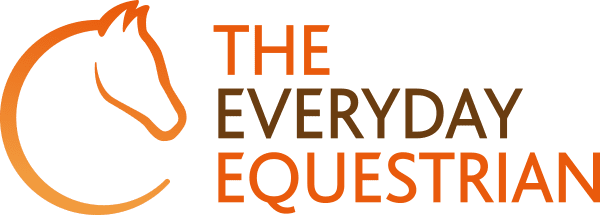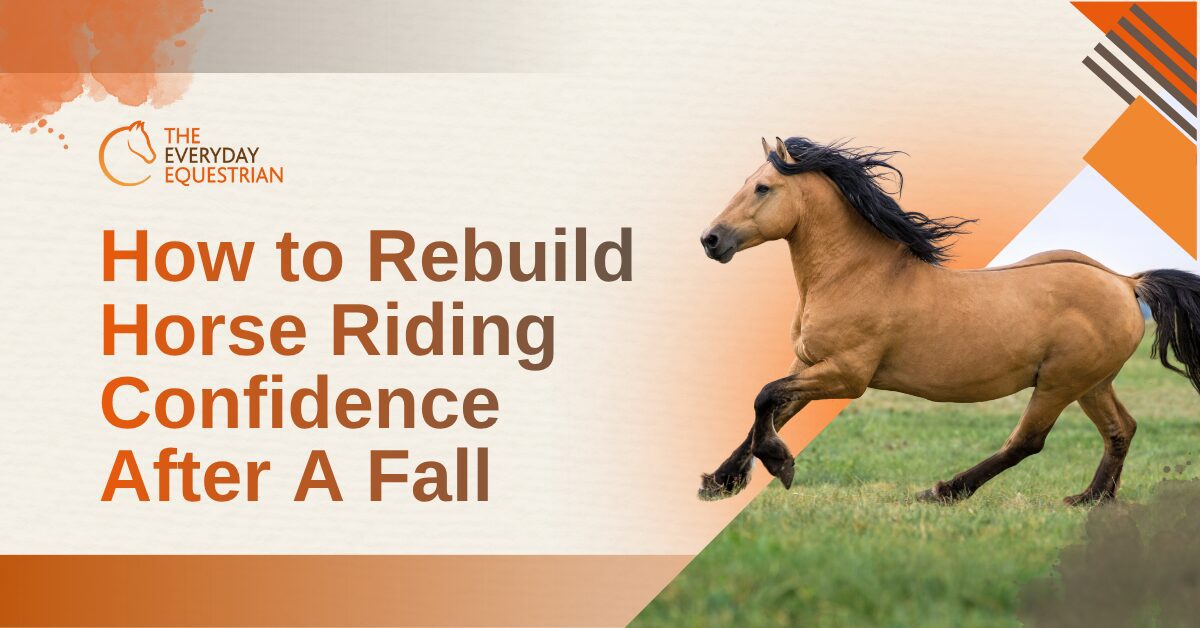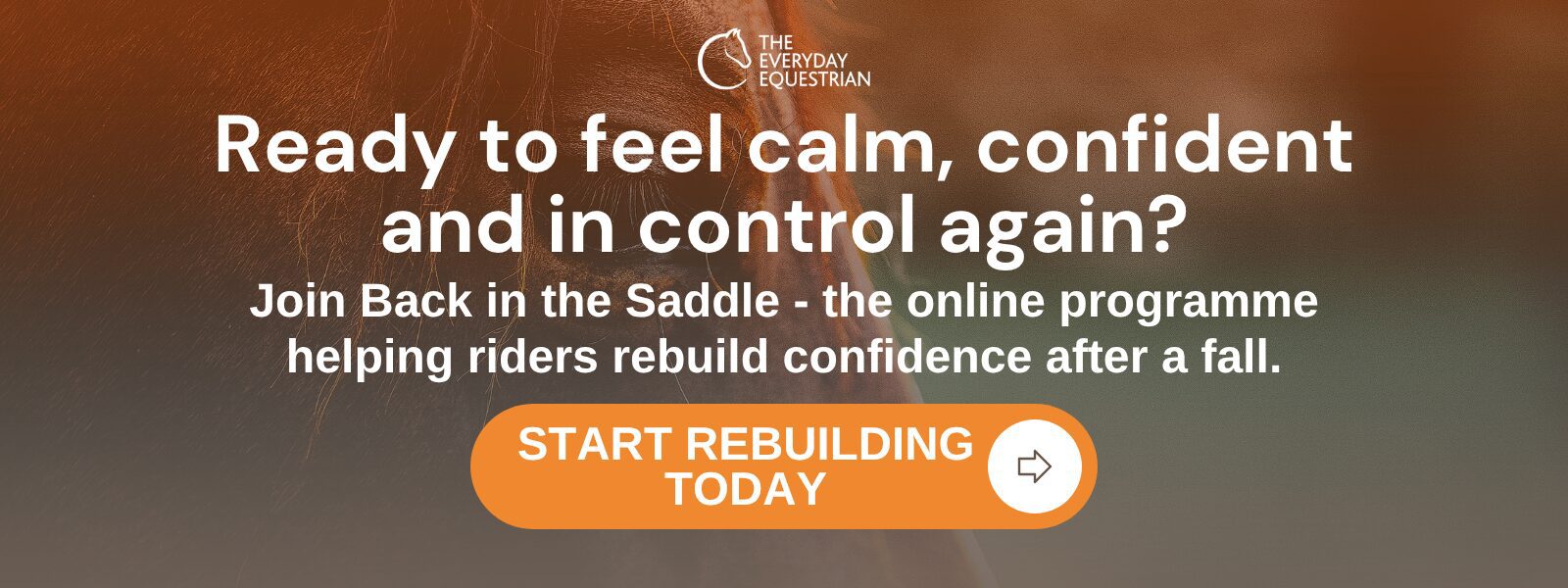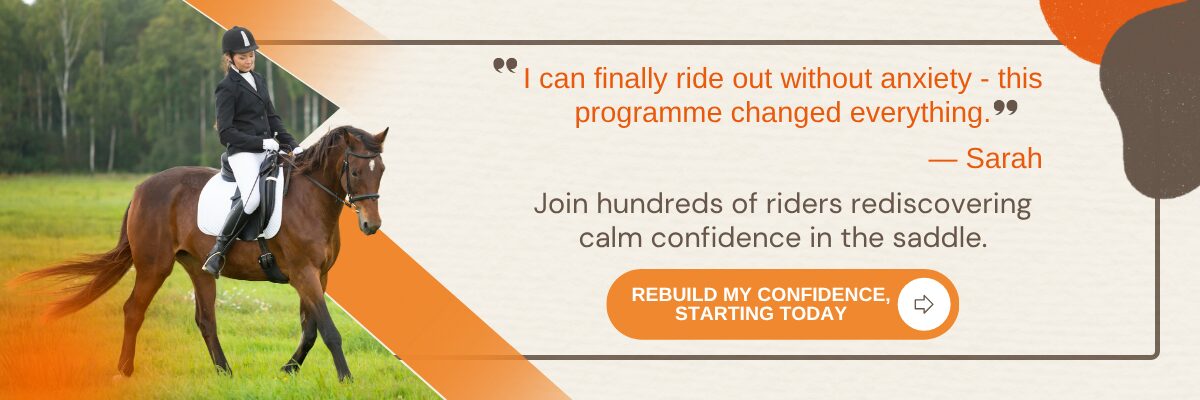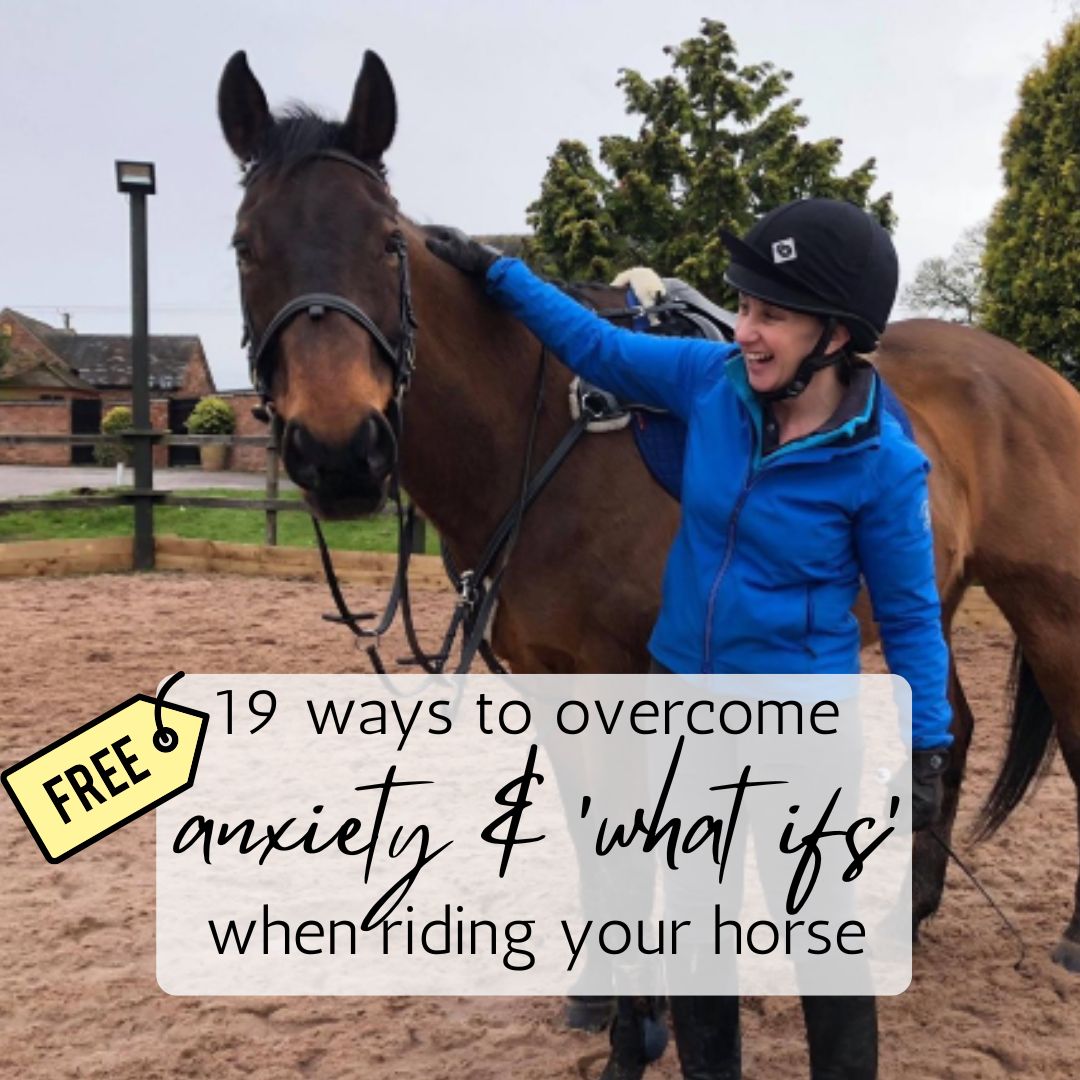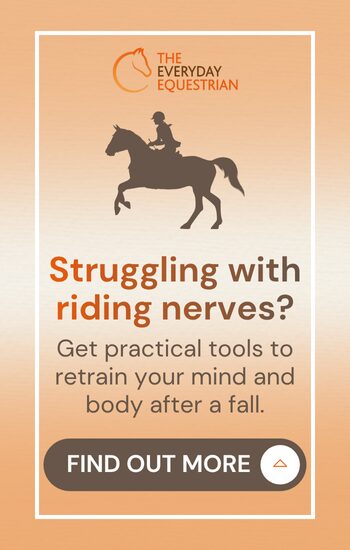Key Takeaways
- Allow yourself time for both physical and mental healing before rushing back into the saddle – you wouldn’t run a marathon on a broken leg, would you?
- Start with small, achievable goals and gradually progress your riding to more challenging riding activities – think of it like climbing a ladder, one rung at a time
- Work with your trusted team of coaches and trainers to rebuild, and consider riding experienced, calm horses during recovery – the right teacher and horse can make all the difference
- Use breathing techniques, visualisation, and mindfulness to manage anxiety and rebuild trust with yourself
- Focus on groundwork and bonding activities to strengthen your relationship with horses before mounted work – sometimes the best place to start is with your feet firmly on the ground
This article also offers practical and mindset advice for you as a rider looking to rebuild your confidence after a fall.
Have you ever wondered why so many riders experience prolonged confidence loss after a significant fall? If you’re reading this, you’re likely amongst them, and that’s perfectly normal. Your journey to rebuild riding confidence after a fall is deeply personal and often more complex than many people realise. Whilst well-meaning friends might suggest you simply “get back on the horse,” the reality is that both your mind and body need time to heal properly.
Falls happen to everyone – from novice riders taking their first lessons to elite equestrians competing on the world stage. What matters most isn’t that the fall happened, but how you approach your recovery. Whether your horse bolted unexpectedly, you came off during a jump, or experienced your first fall after years of confident riding, your path back to the saddle requires patience, strategy, and often professional support.
This comprehensive guide will walk you through evidence-based techniques used by equestrian coaches, sports psychologists, and experienced riders who have successfully navigated this challenging journey. You’ll learn how to rebuild trust with both yourself and horses, develop mental resilience, and create a systematic approach that respects where you are now, whilst moving you steadily towards your riding goals.
Understanding the Impact of a Fall
When you experience a fall, have you noticed how the impact often extends far beyond any physical injuries you might have experienced? You may be feeling all kinds of fear, tension, or even numbness following the fall, with your brain creating a powerful memory imprint of what happened. This ‘survival response’ triggers what’s known as your body’s fight-or-flight response every time you think about riding again. This is a completely normal (and human!) psychological response designed to protect you from perceived danger.
For you as a rider, the emotional aftermath of a fall from your horse can be just as challenging, if not more so, than any physical injury. The “just get back on” mentality that pervades much of traditional equestrianism can actually do more harm than good, particularly when you’re dealing with confidence issues. Rushing back into the saddle too quickly often reinforces fear patterns and can lead to even greater anxiety. Modern understanding of trauma recovery emphasises that pushing through fear without addressing its root causes typically makes the problem worse, not better.
Do you find yourself caught in anxiety cycles where “what if” thinking dominates your mental space? You might imagine worst-case scenarios, find yourself on high alert, feel your heart racing when you approach the barn, or experience physical symptoms like nausea or sweating when you think about riding. There is often a lingering fear of getting hurt again after a fall. These responses indicate that your nervous system is stuck in a hypervigilance, constantly scanning for potential and imagined threats.
Fear after a fall can manifest in different ways. Some riders develop a specific phobia about the activity that caused their fall – perhaps you feel scared about jumping but comfortable with flat work. Others experience more generalised anxiety around horses altogether. Some riders also worry about experiencing pain or injury again, which can increase anxiety. Understanding that fear sets in as a protective mechanism helps normalise these feelings and creates space for healing.
The timeline for your emotional recovery often outlasts physical healing by months, and for some riders even years. Whilst a broken bone might heal in six to eight weeks, rebuilding your rider confidence can take significantly longer. Some riders remember how they walked away from the fall, and this memory can influence their confidence moving forward. Recognising this disparity is crucial for setting realistic expectations and avoiding the frustration that comes from comparing your progress to arbitrary timelines.
Taking Time to Heal Properly
One of the most important steps in rebuilding your confidence is allowing yourself adequate time for both physical AND mental recovery. It’s crucial to consider the well-being and recovery of both you and your horse after a fall, as both of you may need time to heal and regain trust. Rushing back too quickly can worsen confidence issues and potentially lead to additional accidents. Your brain needs time to process what happened, and your body needs to fully recover before you can ride with the security and balance that promotes safe riding.
Should you be assessed by qualified medical professionals before returning to riding? Absolutely! Even seemingly minor falls can result in subtle injuries that affect your balance, coordination, or strength. A thorough evaluation ensures that any physical limitations are addressed before they compromise your riding ability or confidence.
Mental processing of the fall is just as important. Take time to analyse the facts of what happened during the incident without judgement. Was it a training issue, an equipment problem, or simply an accident? What constructive learning can you take from the incident? Understanding the circumstances can help you develop strategies to prevent similar situations in the future. However, avoid getting trapped in endless “what if” scenarios that increase anxiety rather than provide helpful insights. As you work through your recovery, remember to stay within your comfort zone and avoid pushing yourself too quickly; gradual progress is key to rebuilding lasting confidence.
Setting realistic timelines for your confidence rebuilding is essential. Whilst some riders might feel ready to return after a few weeks, others may need several months or even longer. There’s no “normal” timeline – even the best riders in the world have taken over a year to fully regain their confidence after serious accidents. Honour your own values and purpose, and resist pressure from others to progress faster than feels comfortable.
During your recovery period, consider maintaining connection with horses through activities that don’t involve riding. Rediscover your passion for horses – spend time grooming, doing groundwork, or simply spending time around horses can help maintain your bond whilst you focus on healing. Many riders find that this recovery time actually strengthens their relationship with horses and improves their overall horsemanship skills. Before returning to riding, make sure your horse is ready as well by checking for any signs of discomfort or anxiety, and ensure both you and your horse feel confident and prepared.
Working with Professional Support
Finding the Right Instructor
Can the right riding instructor make all the difference in your confidence rebuilding journey? Absolutely. Look for instructors and coaches who have specific experience with post-fall recovery and understand the psychological aspects of riding anxiety. A good confidence-building instructor should be patient, encouraging, share advice and be willing to help you stretch your comfort zone so you can progress at your pace rather than pushing you towards arbitrary goals. Avoid anyone who minimises your fears or suggests that you should simply “get over it.” Effective support and guidance acknowledges the reality of your experience whilst providing practical tools for moving forward.
Professional coaches with experience in rider psychology often incorporate systematic mindset techniques into their teaching. This approach involves gradual exposure to feared activities in carefully controlled steps, allowing your nervous system to build positive associations over time. Think of it like learning to swim again – you wouldn’t start in the deep end, would you? An experienced instructor will structure lessons to maximise success whilst managing the inevitable setbacks and challenges that we face as riders.
When chatting with potential instructors, ask about their experience with anxious riders and their approach to confidence building. A qualified instructor should be able to explain their methodology and provide examples of how they’ve helped other riders overcome similar challenges. They should also be willing to work collaboratively with any mental health professionals you might be seeing.
The benefits of working with an experienced instructor extend beyond just riding technique for you. A skilled teacher can help you develop better body awareness, improve your seat security, and teach you how to read horse behaviour more effectively. These skills directly contribute to both your safety and confidence in the saddle.
Look for instructors who share your values, and emphasise building a strong foundation with a collaborative approach. The best confidence-building coaches understand that small victories and consistent positive experiences are far more valuable for you than dramatic breakthroughs that might not be sustainable.
Mental Health Support
Sometimes the psychological impact of a fall requires professional mental health support beyond what a riding instructor can provide you. Sports psychologists and equestrian performance coaches who specialise in equestrian activities understand the unique challenges faced by horse riders and can provide targeted interventions for riding-related anxiety.
Should you consider working with an equestrian mindset coach or psychologist? If you’re experiencing panic attacks, persistent intrusive thoughts about falling, or if anxiety is significantly impacting your daily life beyond just riding, then yes. These professionals can teach you evidence-based techniques for managing anxiety and help you develop mental resilience and self-belief.
Equine-assisted therapy represents another valuable option for rebuilding your trust and confidence. These programmes combine traditional therapy techniques with horse interactions, allowing you to work through trauma whilst building positive associations with horses. Many riders find this approach particularly effective because it addresses psychological healing within the context of the equestrian environment.
Remember that seeking professional help is a sign of strength, not weakness. Many elite riders work with psychologists and coaches as a regular part of their training regimen, recognising that mental preparation is just as important as physical preparation for optimal performance.
Starting Small with Gradual Progression
The foundation of successful confidence rebuilding lies in starting small and progressing gradually. This approach allows your nervous system to adjust slowly and builds a foundation of positive experiences that gradually outweigh the memory of your fall. Each small success creates momentum for your next step, creating an upward spiral of confidence rather than the downward spiral of fear.
Begin with groundwork exercises that allow you to interact with horses whilst maintaining a sense of control and safety. This ground-based work helps rebuild your connection with horses whilst keeping your feet firmly on the ground.
Using mounting blocks and practising getting on and off horses without actually riding can be an important intermediate step for you. Many riders find that simply sitting in the saddle for a few minutes without going anywhere helps them adjust to being back on a horse. Take as long as you need with this step – there’s no shame in spending several sessions just getting comfortable with mounting and dismounting.
When you’re ready for your first ride back, start with short walk sessions with someone leading the horse. Having a trusted person control the horse’s movement allows you to focus entirely on your own position and comfort level without worrying about managing the horse. Even a 10-minute walk can represent significant progress in your recovery journey.
Gradual progression from walk to trot to canter should happen over weeks or months, not days. Listen to your body and mind at each stage. If trotting feels scary, continue with walking until it becomes completely comfortable. There’s no timeline you need to follow except your own internal sense of readiness.
Set specific, measurable confidence goals for each session rather than focusing on technical riding skills. For example, your goal might be to walk for five minutes without feeling anxious, or to trot for one circle whilst maintaining steady breathing. These small, achievable objectives help build momentum and provide clear markers of progress for you.
Choosing the Right Horse for Recovery
Can the horse you choose for your confidence rebuilding journey significantly impact your success? Without a doubt. Working with an experienced “schoolmaster” – a calm, well-trained horse with extensive experience carrying nervous riders – often accelerates the recovery process by providing you with a safe, predictable partner. This can be especially useful when combined with a few lessons on a schoolmaster horse in a riding school environment.
Ideal confidence-building horses possess several key characteristics that will benefit you. They should be calm under pressure, responsive, and forgiving of rider mistakes. These horses typically have years of experience and have been specifically trained to help nervous or inexperienced riders. They understand their job is to take care of their rider, not to test or challenge them.
A confidence-building horse should be predictable as possible in their responses and reactions for you. Avoid green horses or young horses, or those known for sensitivity during your recovery period, as their unpredictable behaviour can trigger anxiety and potentially cause setbacks. Riding a green horse or a young horse can present additional challenges for riders rebuilding confidence, as these horses often require extra patience, training, and confidence-building measures. Think of it like learning to drive – you wouldn’t choose a race car for your first lesson, would you? The goal is to rebuild trust gradually with a partner who consistently reinforces positive experiences.
Many riders wonder whether they should return to riding their own horse after a fall, especially if their own horse was involved in the accident. Whilst there’s no universal answer, many professionals recommend initially working with a different, more experienced horse until your confidence is fully restored. This approach removes the emotional baggage associated with the specific horse and situation that caused your fall. Issues that arise when a horse is being ridden can be more difficult to manage for nervous riders, making it even more important to choose a suitable partner during recovery.
You can of course also get support from your coach or a professional rider to help keep your horse in work and continue their schooling and development while you rebuild your confidence.
Once your confidence begins to grow, you can gradually transition back to your own horse when you’re ready. However, many riders discover that continuing to work with experienced confidence-building horses provides ongoing benefits for their riding development and peace of mind.
Can the right horse make all the difference in your recovery timeline? 100% yes! Riders who work with appropriate horses often rebuild their confidence in a matter of weeks, whilst those who return to challenging horses too early may struggle for months or even years to regain the same comfort level.
Mental Techniques for Confidence Building
Breathing and Mindfulness
Proper breathing techniques form the foundation of mental confidence building and anxiety management whilst you’re riding. When you feel scared or tense, your breathing naturally becomes shallow and rapid, which signals to your brain that you’re in danger and should remain on high alert. Learning to control your breathing helps interrupt this cycle and promotes a calmer mental state.
Practice specific breathing exercises before mounting and continue using them whilst riding. One effective technique involves breathing in for four counts, holding for four counts, and exhaling for six counts. This pattern activates your parasympathetic nervous system, which promotes relaxation and reduces anxiety. Practice this pattern until it becomes automatic, so you can use it instinctively when you feel nervous.
Progressive muscle relaxation techniques whilst in the saddle help release physical tension that often accompanies riding anxiety for you. Start by deliberately tensing and then relaxing different muscle groups, beginning with your shoulders and working down through your arms, core, and legs. This technique helps you identify areas where you hold tension and teaches you how to consciously release it.
Many riders find that humming or singing whilst riding helps maintain steady breathing and provides a positive focus for their mind. Choose simple songs or melodies that you enjoy, and use them as a tool to regulate your breathing and keep your mind occupied with something pleasant rather than fearful thoughts.
Mindfulness practices help you stay present in the moment rather than getting lost in anxious thoughts about what might happen. Focus on immediate sensations – the feeling of the horse moving beneath you, the sound of hoofbeats, or the rhythm of your breathing. When your mind starts to wander towards fearful scenarios, gently redirect your attention back to these present-moment experiences.
Visualisation and Positive Self-Talk
Visualisation techniques involve mentally rehearsing successful riding experiences to help your brain develop positive associations with riding activities. Spend time each day imagining yourself riding confidently and successfully, focusing on how it feels to be relaxed and secure in the saddle. This mental practice helps reprogram your brain’s automatic responses to riding-related stimuli.
Create detailed mental rehearsals of challenging scenarios and visualise yourself handling them successfully and confidently. For example, if you’re worried about your horse spooking, imagine feeling the horse tense beneath you and visualise yourself taking steps to stay balanced, breathing deeply, and calmly managing the situation. This mental preparation helps build confidence for real-world challenges.
Reframe negative thoughts with constructive questions, instead of trying to force positive thinking. Instead of telling yourself “I shouldn’t be scared,” ask yourself “What can I do right now to feel safer?” or “What would help me feel more confident in this moment?” This approach acknowledges your feelings whilst directing your mind towards problem-solving rather than self-criticism.
Develop a collection of positive riding affirmations that resonate with your personal experience and goals. Examples might include “I am learning to trust myself and my horse,” “I am becoming more confident with each ride,” or “I have the skills and knowledge to ride safely.” Repeat these affirmations regularly, especially before and during rides.
Replace “what if” catastrophic thinking with “what is” present-moment awareness. When your mind starts spinning stories about potential disasters, gently redirect your attention to what is actually happening right now. This practice helps break the cycle of anticipatory anxiety that often makes you feel worse than the actual riding experience.
Physical Preparation for Confident Riding
Physical fitness and body awareness play crucial roles in your riding confidence. When you feel strong, balanced, and secure in your seat, you’re naturally more confident in your ability to handle unexpected situations. Poor physical condition can contribute to falls and increases anxiety about your ability to stay safe on horseback.
Core strengthening exercises improve your seat security and stability in the saddle. Focus on exercises that build deep abdominal strength, such as planks, dead bugs, and bird dogs. A strong core helps you maintain your position even when your horse moves unexpectedly, which directly translates to increased confidence whilst riding.
Balance and flexibility work off the horse enhances your ability to move with your horse rather than fighting against their motion. Activities like yoga, Pilates, or simple balance exercises on unstable surfaces help develop the proprioceptive awareness that makes you a more secure and confident rider.
Improved fitness directly impacts your riding confidence by giving you more physical resources to draw upon when challenges arise. When you’re fit and strong, you’re less likely to fatigue quickly, which means you can maintain good position and control throughout your ride. This physical competence provides a foundation for mental confidence.
For you as a rider recovering from fall-related injuries, specific rehabilitation exercises may be necessary before returning to full riding activities. Work with physiotherapists or fitness professionals who understand the demands of riding to develop a targeted programme that addresses your specific needs and limitations.
Cross-training activities like swimming, cycling, or walking help maintain cardiovascular fitness during periods when you’re not riding regularly. Staying active provides mental health benefits through endorphin release and helps you feel strong and capable, which supports overall confidence in all areas of life, including riding.
Building Trust Through Groundwork
Groundwork exercises provide an excellent foundation for rebuilding your confidence because they allow you to interact with horses whilst maintaining control and staying safely on the ground. These activities help rebuild communication and trust between you and horses, which naturally translates to greater confidence when you eventually return to riding.
Ground exercises that improve communication and control include basic leading, backing, yielding hindquarters and forequarters, pole work and lunging. These activities teach you how to read horse body language more effectively and give you tools for managing horse behaviour from the ground. The confidence you develop in your ability to communicate with and control horses carries over into mounted work.
Leading, lunging, and liberty work help rebuild the partnership between you and horses by establishing clear communication and mutual respect. When you can successfully manage a horse’s movement and behaviour from the ground, you naturally feel more confident about your ability to influence their behaviour from the saddle.
Groundwork confidence translates directly to mounted confidence because the communication skills and horse-handling abilities you develop on the ground remain available to you when riding. If you can get a horse to move away from pressure, stand quietly, or follow your direction whilst you’re on the ground, you know you can influence their behaviour from the saddle as well.
Using groundwork sessions on days when riding feels too overwhelming helps maintain your connection with horses whilst respecting your current emotional state. These sessions keep you engaged with horses and often help you feel more positive about your next mounted session. Sometimes spending time on the ground is exactly what you need to feel ready to get back in the saddle.
Many riders discover that their groundwork skills improve significantly during their confidence rebuilding process, making them better horsemen overall. This enhanced understanding of horse behaviour and communication often makes them safer and more effective riders than they were before their fall.
Creating a Support System
Building a strong support system is essential for your successful confidence rebuilding. Surround yourself with people who understand your journey and can provide encouragement, practical help, and emotional support when you need it most. The right support network can make the difference between giving up and successfully returning to confident riding.
The benefits of riding with trusted friends or yard buddies cannot be overstated. Having supportive people around provides emotional comfort and practical safety benefits. Choose riding companions who understand your situation and won’t pressure you to progress faster than feels comfortable. Good support people celebrate your small victories and remain patient during setbacks. Finding ‘your people’ can make a huge difference to how you think, feel and ride.
Having another person present provides both safety and emotional support for you. Even if they’re not directly involved in your lesson, knowing someone is there who could help if needed provides peace of mind that allows you to focus on your riding rather than worrying about potential emergencies.
Finding supportive riding communities online and offline can provide valuable perspective and encouragement. Many riders have successfully overcome riding fears, and hearing their stories can provide hope and practical strategies for your own journey. Online forums, social media groups, and local riding clubs often have members who understand exactly what you’re going through.
Learning how to communicate your needs to barn friends and instructors also ensures that you get the support you need without feeling judged or pressured. Be clear about your current comfort level, your goals for each session, and what kind of support would be most helpful. Most people want to help but may not know how unless you tell them specifically what you need.
Remember that asking for help is a sign of strength, not weakness. Building confidence after a fall requires courage, and part of that courage involves reaching out to others when you need support. The horse community generally understands the challenges of rebuilding confidence and most people are willing to help when asked directly.
Recognising and Celebrating Progress
Learning to recognise and celebrate small victories is crucial for maintaining your motivation during the confidence rebuilding process. Progress often happens in small increments that might not seem significant day to day, but add up to major achievements over time. Training yourself to notice and appreciate these small wins helps maintain forward momentum.
The importance of acknowledging small victories cannot be overstated – even 10-minute rides count as significant progress when you’re rebuilding confidence. Every time you mount without feeling overwhelmed, every ride where you maintain steady breathing, and every session where you end feeling positive rather than anxious represents meaningful progress towards your goals.
Keeping a confidence journal helps track improvements that might otherwise go unnoticed. Write down something positive about each interaction with horses, no matter how small. Over time, you’ll be able to look back and see clear patterns of improvement that provide motivation during difficult days.
Learning how to handle setback days without losing overall progress is an essential skill for you. Bad days are normal parts of the confidence rebuilding process, not signs that you’re failing or moving backward. When you have a difficult session, focus on what you learned rather than what went wrong, and remember that tomorrow offers a fresh start.
Celebrating milestones like your first post-fall trot or canter helps mark significant achievements in your journey. Plan small celebrations for these moments – perhaps treating yourself to new riding equipment, sharing the achievement with supportive friends, or simply taking time to acknowledge how far you’ve come.
Create specific, measurable goals that allow you to track progress objectively. Instead of vague goals like “feel more confident,” set specific targets like “walk for 15 minutes without feeling anxious” or “trot three times around the arena whilst maintaining steady breathing.” These concrete goals make progress visible and provide clear targets to work towards.
When to Seek Additional Help
Recognising when you need additional professional help is an important part of taking care of yourself during the confidence rebuilding process. Whilst some anxiety and fear after a fall is completely normal, certain warning signs indicate that you might benefit from more intensive support or intervention.
Warning signs that anxiety is becoming overwhelming include persistent panic attacks, intrusive thoughts that interfere with daily life, complete avoidance of horses or riding-related activities, or physical symptoms like insomnia or loss of appetite that persist for weeks. If your fear is significantly impacting your overall quality of life, it’s time to seek professional help.
Professional resources for severe riding anxiety or PTSD include sports psychologists who specialise in equestrian activities, therapists trained in trauma treatment, and medical professionals who can assess whether medication might be helpful as part of your treatment plan. Don’t hesitate to seek help if you’re struggling – effective treatments are available.
You’ll know you need more time before returning to riding if the thought of mounting a horse triggers severe anxiety, if you’re having nightmares about falling, or if you find yourself making excuses to avoid any horse-related activities. Listen to these signals from your mind and body, and honour the message that you need more time to heal.
Alternative ways to stay connected to horses during extended recovery periods include volunteering at therapeutic riding programmes, spending time grooming and caring for horses without riding, learning about horse behaviour and training from the ground, or taking up horse photography or art. These activities maintain your connection to the equestrian world whilst respecting your need for time away from riding.
Remember that taking a break from riding doesn’t mean giving up forever. Many riders who take extended time off return to riding stronger and more confident than before. Sometimes stepping away completely for a period allows for deeper healing that wouldn’t be possible whilst trying to push through fear.
Frequently Asked Questions
How long does it typically take to rebuild confidence after a fall?
There’s no standard timeline for rebuilding your riding confidence, as recovery varies greatly between individuals. Some riders regain their confidence within a few days or weeks, whilst others may need longer. Factors that influence recovery time include the severity of the fall, any physical injuries sustained, previous riding experience, and individual psychological resilience. Focus on your own experience and your journey, rather than comparing your progress to others or arbitrary timelines.
Is it normal to feel more nervous about riding after years of experience?
Yes, it’s completely normal for you as an experienced rider to develop riding anxiety after a fall, regardless of your previous confidence level. Your brain doesn’t distinguish between novice and experienced riders when processing trauma – the fear response is designed to protect you from perceived danger. Many riders are surprised by how much a fall affects them after years of confident riding, but this reaction indicates a healthy survival instinct rather than any personal failing. Even Olympic-level riders experience confidence issues after accidents, showing that skill level doesn’t provide immunity to post-fall anxiety.
Should I get back on the same horse that I fell from?
Whether you should return to the same horse depends on several factors including the cause of the fall, the horse’s temperament, and your current anxiety level. If the fall was due to an accident or circumstances beyond the horse’s control, and the horse is generally calm and reliable, you might easily return to riding them. However, many professionals recommend initially rebuilding confidence on a different, more experienced “schoolmaster” horse to remove emotional baggage from the equation. This approach allows you to focus on your own recovery without additional anxiety about the specific horse and situation that caused your fall.
What should I do if I start having panic attacks whilst riding?
If you experience panic attacks whilst riding, prioritise your immediate safety by asking your instructor to stop or dismount if necessary. Practice the breathing techniques you’ve learned – breathe in for four counts, hold for four, and exhale for six counts to activate your body’s relaxation response. Remember that panic attacks, whilst frightening, are not dangerous and will pass. If panic attacks persist or become frequent, consider working with a sports psychologist or mental health professional who can teach you additional coping strategies and help address the underlying anxiety through techniques like cognitive behavioural therapy.
Can wearing protective gear help with confidence rebuilding?
Yes, appropriate protective equipment can significantly boost your confidence during the rebuilding process. Whilst safety gear like riding hats (which should always be worn when riding), body protectors, air jackets and neck straps can always be used regardless of confidence level, they can provide additional psychological comfort for anxious riders. The knowledge that you’re taking every reasonable precaution to protect yourself can help reduce “what if” thinking and allow you to focus on positive aspects of riding. However, protective equipment should supplement, not replace, proper instruction, suitable horses, and gradual progression in your confidence rebuilding programme.
Introduction to Riding Confidence
Riding confidence is at the heart of every enjoyable and successful horse riding experience for you. Whether you’re a new rider or have spent years in the saddle, confidence after a fall can be shaken, leaving even the most experienced riders feeling uncertain. It’s important to remember that losing confidence is a normal response to a fall, and it doesn’t mean you’re not a good rider or that you’ll never feel secure again. Confidence is not something you either have or don’t have, it’s a skill that can be developed, strengthened, and rebuilt over time.
After a fall, both your mind and body may need time to recover, and that’s perfectly okay. Your journey to regaining riding confidence involves understanding your fears, setting realistic goals, and surrounding yourself with the right support. With patience, practice, and a positive mindset, you can overcome setbacks and return to riding with renewed assurance. No matter where you are in your riding journey, know that confidence can be restored, and every step forward is worth celebrating.
Creating a Safe and Supportive Environment
A safe and supportive environment is essential for you when rebuilding riding confidence after a fall. Spending time with your horse on the ground, can help you reconnect and rebuild trust. This foundation is key to feeling secure when you’re ready to ride again. Working with a knowledgeable riding coach can make all the difference, as they can tailor lessons to your needs and help you regain confidence at your own pace.
Don’t underestimate the value of riding with a friend or joining group lessons. Having someone by your side can provide reassurance and encouragement, making each ride feel less daunting for you. It’s also important to ensure your horse is well-trained and ready for the activities you plan to do. Using safety equipment like a body protector and a neck strap can give you extra peace of mind, allowing you to focus on enjoying your ride rather than worrying about what might go wrong. By prioritising safety and support, you create the best possible environment for your confidence to grow.
Additional Tips
Beyond creating a supportive environment, there are several practical steps you can take to rebuild your riding confidence. Start small and allow yourself to progress at your own pace – there’s no need to rush. Begin with groundwork exercises to reestablish your connection with your horse and build trust from the ground up. When you’re ready, a lunge lesson can be a gentle way to get back in the saddle, as it allows you to focus on your balance and position whilst someone else leads the horse.
Practice self-compassion throughout your journey. It’s normal for you to experience confidence issues or feel nervous after a fall, but remember that every rider faces setbacks at some point. Focus on positive experiences and celebrate small victories, whether it’s a calm walk around the arena or a successful groundwork session. Each step forward, no matter how small, is progress. By starting small, focusing on what feels right for you, and acknowledging your achievements, you’ll gradually rebuild your confidence and rediscover the joy of riding.
Final Thoughts on Recovery
Recovering from a fall and rebuilding your riding confidence is a personal journey that takes time, patience, and understanding. It’s completely normal for you to feel scared or anxious after a fall – these feelings are part of the process.
Remember, every rider’s path to confidence is unique, and progress may come in small steps rather than big leaps.
Be gentle with yourself and recognise that setbacks are a natural part of learning and growth. Focus on your training, celebrate your progress, and don’t compare your journey to anyone else’s. With the right support, mindset, and a commitment to moving forward, you can overcome your fears and become a more confident rider. No matter how long it takes, what matters most is that you keep going—because with persistence and self-belief, you can regain your confidence and enjoy riding once again.
